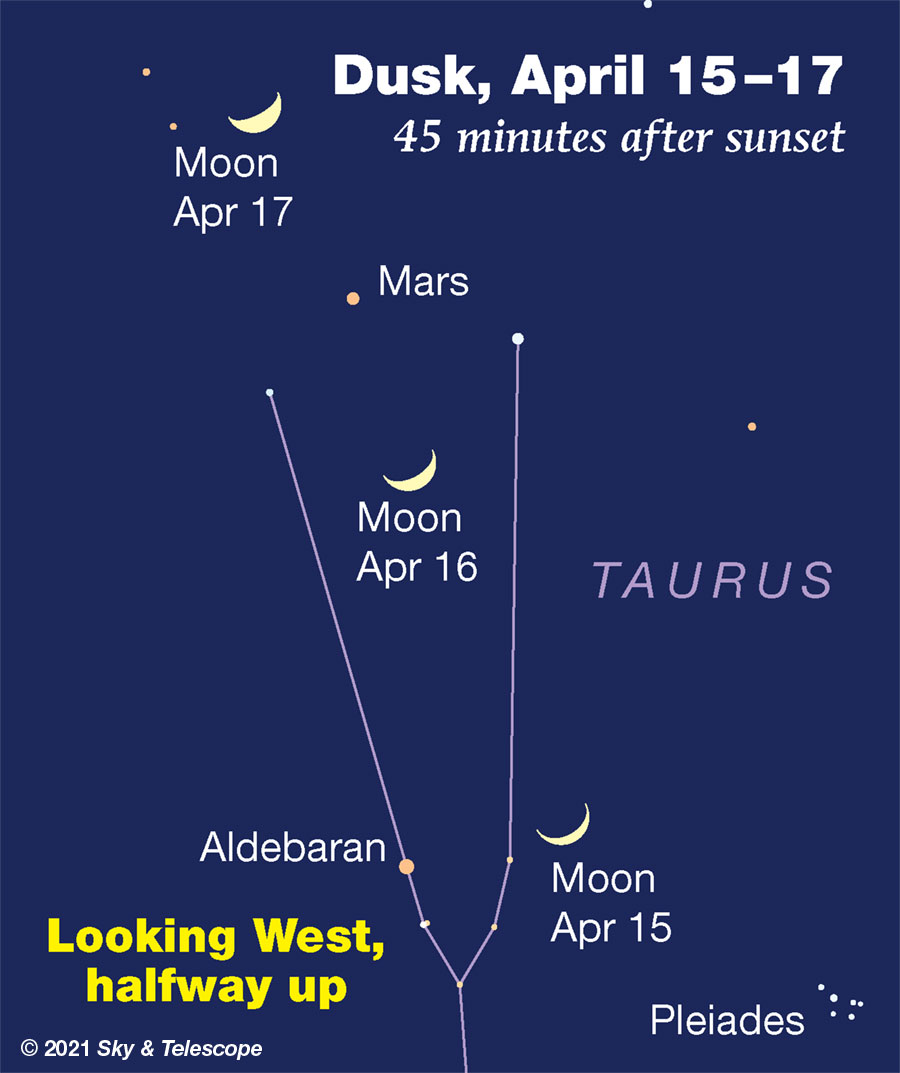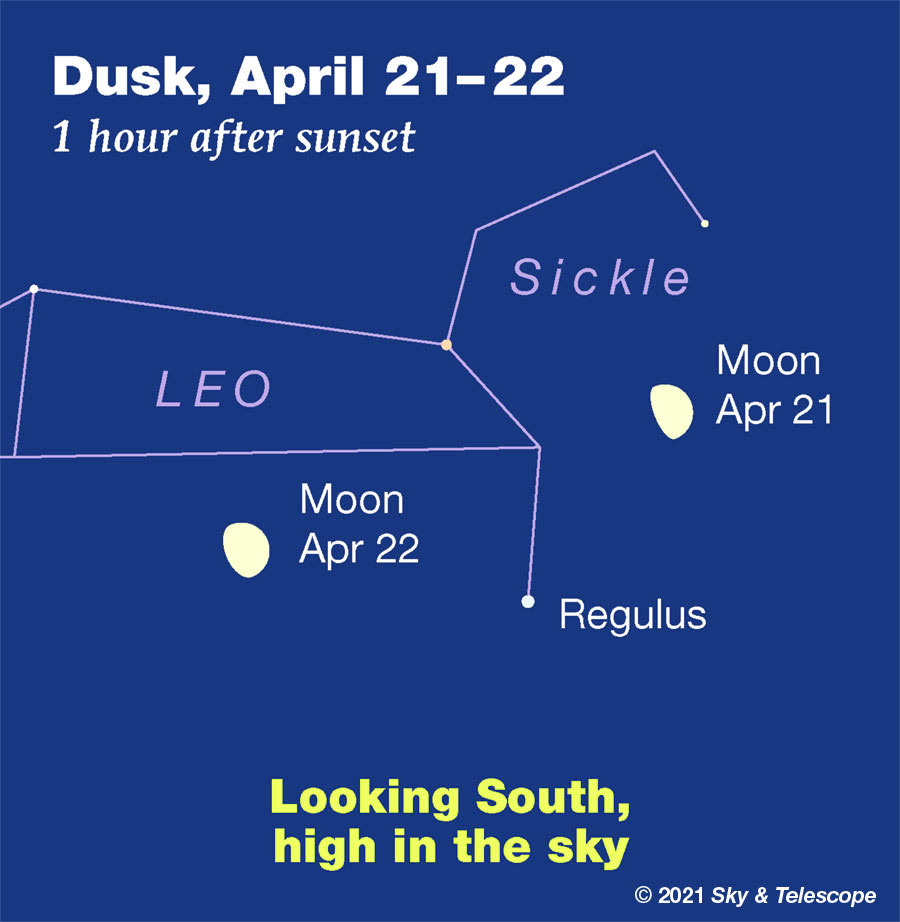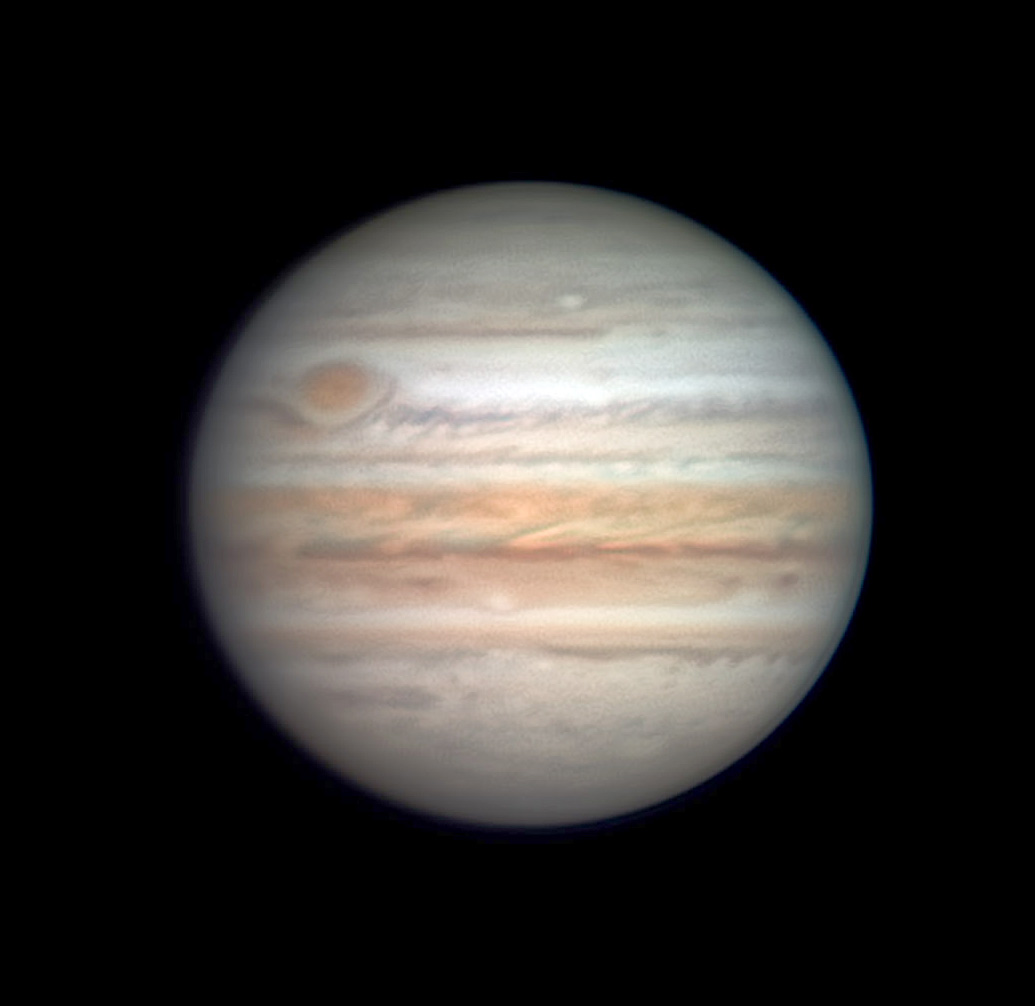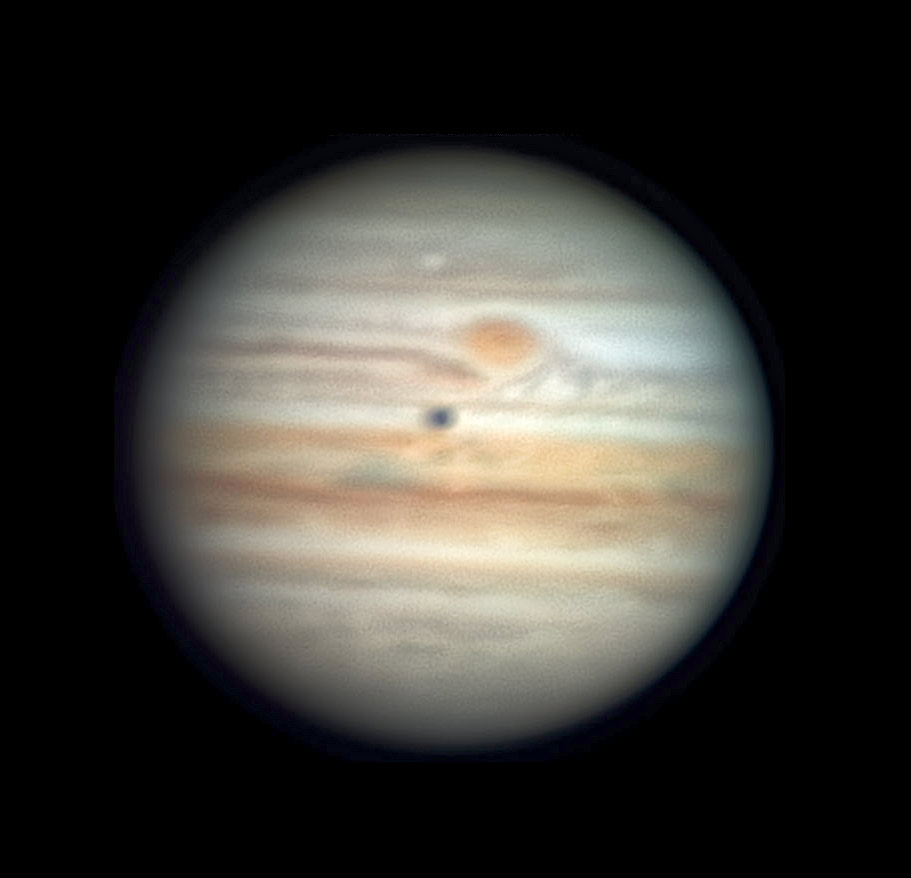Novae update: Nova Cassiopeiae 2021 (V1405 Cas) was holding at about magnitude 7.9 as of April 21st. It's been about like that for four weeks now, maybe with a gradual rebrightening. But it's now very low in the north just after nightfall, especially as seen from southerly latitudes; you're better off catching it when it's higher in the north-northeast before the start of dawn. See Bright Nova Erupts in Cassiopeia.
Meanwhile, Nova Sagittarii 2021 No. 2 (V6595 Sgr) and Nova Scorpii 2021 have both faded to magnitude 11. See A Bouquet of Novae Brightens April Nights.
FRIDAY, APRIL 16
■ This evening the waxing crescent Moon forms a quadrilateral with Mars above it and Taurus's horntip stars, Beta and fainter Zeta Tauri, to the sides as shown below.

SATURDAY, APRIL 17
■ Now the Moon shines upper left of tiny Mars, as shown above.
■ Bright Arcturus ascends in the eastern sky during evening while Capella, its close match for brightness, descends in the northwest. They stand at exactly the same altitude around the end of twilight, depending on your location.
■ And at that time, the Sickle of Leo stands upright high in the south. Its bottom star is Regulus, the brightest of Leo. Leo himself is walking westward. The Sickle forms his front leg, chest, mane, and part of his head. Off to the left, a long right triangle forms his hind end and long tail.
■ Spot brighter Procyon nearly four fists to the lower right of Regulus. About halfway along that line and just a bit below, look for the dim head of Hydra, the Sea Serpent.
SUNDAY, APRIL 18
■ The Moon shines in central Gemini this evening under Pollux and Castor, forming a long, tall triangle with them. Farther left of the Moon is Procyon. Much farther right of the Moon is Capella.
■ At this time of year, the two Dog Stars stand vertically aligned in late twilight. Look directly southwest. Brilliant Sirius in Canis Major is below, and Procyon in Canis Minor is high above. They're roughly two fists apart.
■ This is also when, as the last of twilight fades away, the bowl of the dim Little Dipper extends straight to the right of Polaris in the north.
■ And high above the end-stars of the Little Dipper's bowl, you'll find the end-stars of the Big Dipper's bowl. That pair is almost twice as wide apart.
MONDAY, APRIL 19
■ First-quarter Moon (exact at 2:59 a.m. EDT). Look just right of the Moon for Pollux and Castor nearly lined up with it. Lower left of the Moon shines Procyon.
TUESDAY, APRIL 20
■ This evening, use binoculars to pick out M44, the Beehive star cluster, about 4° or so below the Moon. That's roughly two-thirds or three-quarters the width of a typical binocular's field of view. This much moonlight is hardly ideal for viewing a deep-sky object, but the Beehive stars are not difficult in binocs, and the Moon does make a very handy reference point to start from.
■ Arcturus shines brightly in the east these evenings. It's the pointy end of a long, narrow kite-shaped asterism formed by the brightest stars of Bootes, the Cowherd. The kite is currently lying on its side, extending to Arcturus's left. The head of the kite, at the far left, is bent slightly upward. The kite is 23° long: about two fist-widths at arm's length.
WEDNESDAY, APRIL 21
■ The Moon this evening form an isosceles triangle with Regulus and Algieba (Gamma Leonis), the second-brightest star of Leo's Sickle, as shown below. The exact height of the isosceles triangle will depend on your longitude, since the Moon moves eastward by an appreciable amount each hour.
The scenes here are always plotted exact for an observer near the middle of North America, at latitude 40° N, longitude 90° W. If you're near the East Coast the Moon will be just a little to the right of where it's plotted below. On the West Coast the Moon will appear a little left of where plotted.
By how much? Measure by the fact that the gap between the two Moons below is 24 hours of lunar motion.

■ In the early-morning hours of Thursday the Lyrid meteor shower, usually weak but sometimes unpredictable, should at its maximum activity. The light of the waxing gibbous Moon will interfere until the Moon sets about an hour before the first glimmer of dawn. That dark hour is the best window to plan for. See Robert Lunsford's Viewing the Lyrids in 2021.
THURSDAY, APRIL 22
■ Now the Moon forms a triangle with Regulus and Algieba on their left side rather than their right side, as shown above.
This new triangle is almost perfectly equilateral around the time twilight ends in the Eastern and Central time zones.
FRIDAY, APRIL 23
■ The Arch of Spring. As night descends, look high in the west for Pollux and Castor lined up almost horizontally depending on your latitude. These two stars, the heads of the Gemini twins, form the top of the enormous Arch of Spring. To their lower left is Procyon, the left end of the Arch. Farther to their lower right is the other end, formed by Menkalinan (Beta Aurigae) and then brilliant Capella.
This spring the Arch has an intruder: little Mars. Tonight you'll find Mars the same distance lower right from the Castor-Pollux pair as it is lower left from Capella. The whole array sinks in the west through the evening.
Modern skywatchers are not alone in seeing the Arch of Spring as one big asterism. Extend it down past Procyon to add Sirius, and you've got the Hawai‘ian Canoe-Bailer of Makali‘i. Looks big enough to bail the ocean.
■ The Moon shines on the opposite side of the sky after dark. Look upper left of the Moon by less than fist at arm's length for 2nd-magnitude Denebola, the tail star of Leo.
Nearly four fists left of the Moon shines brighter Arcturus, magnitude 0, the leading light of Bootes.
SATURDAY, APRIL 24
■ This evening Arcturus shines about three fists left of the Moon.
And look below the Moon by hardly more than half that distance, and perhaps a bit left, to find Spica, the leading light of Virgo.
This Week's Planet Roundup
Mercury and Venus remain buried in the sunset, but not for long. Next week they'll start emerging into low twilight view together.
Mars (magnitude +1.4, crossing from Taurus into Gemini) shines in the west after dark. In a telescope Mars is a mere 5 arcseconds wide, just a tiny shimmering blob.
Jupiter and Saturn (both in dim Capricornus) are low in the southeast just before and during early dawn. Jupiter grabs the eye at magnitude –2.1. Saturn glows a thirteenth as bright at magnitude +0.7. Catch Saturn a little more than a fist at arm's length to Jupiter's right or upper right before dawn grows too bright.


Uranus and Neptune remain hidden low in evening and morning twilight, respectively.
All descriptions that relate to your horizon — including the words up, down, right, and left — are written for the world's mid-northern latitudes. Descriptions that also depend on longitude (mainly Moon positions) are for North America.
Eastern Daylight Time, EDT, is Universal Time minus 4 hours. Universal Time is also known as UT, UTC, GMT, or Z time. To become more expert about time systems than 99% of the people you'll ever meet, see our compact article Time and the Amateur Astronomer.
Want to become a better astronomer? Learn your way around the constellations. They're the key to locating everything fainter and deeper to hunt with binoculars or a telescope.
This is an outdoor nature hobby. For an easy-to-use constellation guide covering the whole evening sky, use the big monthly map in the center of each issue of Sky & Telescope, the essential magazine of astronomy.
Once you get a telescope, to put it to good use you'll need a detailed, large-scale sky atlas (set of charts). The basic standard is the Pocket Sky Atlas (in either the original or Jumbo Edition), which shows stars to magnitude 7.6.

Next up is the larger and deeper Sky Atlas 2000.0, plotting stars to magnitude 8.5; nearly three times as many. The next up, once you know your way around, are the even larger Interstellarum atlas (stars to magnitude 9.5) or Uranometria 2000.0 (stars to magnitude 9.75). And be sure to read how to use sky charts with a telescope.
You'll also want a good deep-sky guidebook, such as Sky Atlas 2000.0 Companion by Strong and Sinnott, or the bigger (and illustrated) Night Sky Observer's Guide by Kepple and Sanner.
Can a computerized telescope replace charts? Not for beginners, I don't think, and not on mounts and tripods that are less than top-quality mechanically, meaning heavy and expensive. And as Terence Dickinson and Alan Dyer say in their Backyard Astronomer's Guide, "A full appreciation of the universe cannot come without developing the skills to find things in the sky and understanding how the sky works. This knowledge comes only by spending time under the stars with star maps in hand."
![]() Audio sky tour. Out under the evening sky with your
Audio sky tour. Out under the evening sky with your
earbuds in place, listen to Kelly Beatty's monthly
podcast tour of the heavens above. It's free.
"The dangers of not thinking clearly are much greater now than ever before. It's not that there's something new in our way of thinking, it's that credulous and confused thinking can be much more lethal in ways it was never before."
— Carl Sagan, 1996
"Facts are stubborn things."
— John Adams, 1770
 15
15









Comments
Rod
April 16, 2021 at 11:29 am
"Jupiter and Saturn (both in dim Capricornus) are low in the southeast just before and during early dawn." Indeed, Jupiter and Saturn presented some lovely views for me this morning. [Observed 0500-0600 EDT/0900-1000 UT. Sunrise 0629 EDT/1029 UT. I used 14-mm for 71x views and true FOV a bit more than 60 arcminutes. Lovely views of Saturn in Capricornus this morning. Saturn with rings, Titan visible along with Rhea moons. Stellarium 0.21.0 shows Titan mv +8.76 and Rhea mv + 10.14. Scattered all around Saturn’s position in Capricornus, fainter stars in the FOV, some 9th-11th apparent magnitudes. This would make for a good photo. Jupiter was lovely too in Capricornus this morning. The 4 Galilean moons visible and Mu Capricorni star less than 4 arcminutes angular separation from Jupiter on the same side as Io, Europa, and Callisto moons nearly in the same line. Ganymede was on the other side of Jupiter and the NEB and SEB cloud bands visible. It seems like Jupiter had 5 Galilean moons this morning However Jupiter 5.479 au from Earth, Mu Cap star about 88 light-years distance according to Stellarium 0.21.0. Mu Cap mv +5.05. As the sky brightened as sunrise approached, about 0550-0600 EDT, I could see with unaided eyes the star Deneb Algedi close to 3-degrees angular separation from Jupiter. Stellarium 0.21.0 shows mv + 2.85. An enjoyable, cool, crisp, early spring morning viewing in Capricornus with my 90-mm refractor telescope. Temperature 5C with winds 290/10 knots.]
You must be logged in to post a comment.
New Jersey Eclipse Fan
April 16, 2021 at 7:02 pm
Um, I was still asleep at that time. But thanks for the report, as usual!
You must be logged in to post a comment.
Alan MacRobertPost Author
April 20, 2021 at 8:52 am
So did I!
You must be logged in to post a comment.
Anthony Barreiro
April 16, 2021 at 4:16 pm
When I went out in the back yard around astronomical dusk last night, Pollux and Castor were a lot lower in the western sky than I expected. Turns out I was looking at Mars and Beta Tauri. They were right where Pollux and Castor would be in two hours, and remarkably similar in color, brightness, separation, and orientation. Gemini was hiding behind a tree.
You must be logged in to post a comment.
mary beth
April 16, 2021 at 10:46 pm
My husband noticed that also, on Monday or Tuesday night!
You must be logged in to post a comment.
Anthony Barreiro
April 16, 2021 at 11:26 pm
I hope he wasn't as befuddled as I was, until I figured out my mistake.
You must be logged in to post a comment.
mary beth
April 17, 2021 at 1:50 pm
Fortunately I immediately checked Stellarium to figure out what was going on! If not for technology we probably would have stayed confused!
You must be logged in to post a comment.
Alan MacRobertPost Author
April 21, 2021 at 9:56 am
> ...Pollux and Castor... Turns out I was looking at Mars and Beta Tauri.
I did that too! (I meant to post this reply here, not to an earlier comment.)
You must be logged in to post a comment.
Rod
April 17, 2021 at 10:18 am
Much fun here Anthony and mary beth. On 02-April I viewed Mars near the open cluster NGC 1746 in Taurus. Shortly after sunset I started viewing using my 90-mm refractor telescope but initially was viewing Aldebaran. I was almost *befuddled* 🙂 Don't forget, tonight near 2030-2100 EDT, the waxing crescent Moon and M35 in Gemini are about 0.5 degrees angular separation. Should make for some good binocular and telescope views this evening if skies are more clear in my area.
You must be logged in to post a comment.
mary beth
April 17, 2021 at 1:48 pm
This is beginning to sound like a Texas Aggie joke: “How many S&T commenters does it take to figure out...??” LOL.
I sure hope we clear up tonight because I’m looking forward to that April crescent moon have not had a chance to see any waxing crescent yet because of the weather. Rod, I hope your skies clear as well! I know you’ve been looking forward to this! Also, I replied late Thursday to your comment about the dark skies on last week’s column. Not sure if you saw it since it was so late.
You must be logged in to post a comment.
Rod
April 18, 2021 at 12:03 am
mary beth, no clear skies, mostly altocumulus from WNW. I did see a bit of the show with the Moon and M35. [Observed 2045-2130 EDT/0045-0130 UT. I did observe the waxing crescent Moon and M35 in Gemini this evening but very difficult.
Altocumulus clouds covered much of the sky and moved by,
obscuring. I could see lunar craters along the terminator line and at times, a few brighter members of M35 popped in and out of view, perhaps 7.4 apparent magnitude members. This would make a great view if the sky was clear but altocumulus clouds did not help. I used 32-mm plossl for 31x views. True FOV ~ 96' angular size. Starry Night shows the Moon and M35 ~ 32' angular separation in the sky this evening. Some brighter stars like Arcturus and Capella were visible unaided eyes.]
You must be logged in to post a comment.
Tony
April 18, 2021 at 12:15 am
Venus is already worth looking for. On southern Vancouver Island this Saturday (the 17th) dusk it was easy in handheld 16x50 binoculars five minutes after sunset.
You must be logged in to post a comment.
mary beth
April 18, 2021 at 2:16 pm
Timely and interesting:
https://astronomy.com/magazine/stephen-omeara/2014/02/moonlight-and-paul-revere
You must be logged in to post a comment.
Rod
April 20, 2021 at 8:14 am
mary beth et al. Some enjoyable views of Jupiter and Saturn this morning at 129x using my 90-mm refractor telescope. Great Red Spot visible and Europa shadow transit underway. 0500-0600 EDT. Saturn had another moon near Titan's sky position too 🙂
Saturn was easier view because its elevation angle in SE sky higher up (near 19-degrees altitude). The star TYC6349-766-1 near 2 arcminute angular separation from Saturn according to Starry Night Pro Plus 8. SIMBAD portal HD 358640, mv + 9.939, stellar parallax 1.6373 mas, distance 1992 LY. Spectral type K0. This star was close to Titan’s position in the sky so looked like another moon of Saturn while I observed . I could see Titan and Rhea moons as well. Stellarium 0.21.0 shows Titan mv +8.74, Rhea mv +10.12. Saturn's distance 10.13 au.
You must be logged in to post a comment.
mary beth
April 20, 2021 at 1:24 pm
What a worthwhile cause to get up early!
You piqued my interest in Titan so I went to the Wikipedia page and found so much great information. Such fascinating and unique characteristics. I had no idea it had lakes, mountain, sand dunes, possibly volcanos....
Nice global geologic map on the page as well.
https://en.wikipedia.org/wiki/Titan_(moon)
You must be logged in to post a comment.
You must be logged in to post a comment.